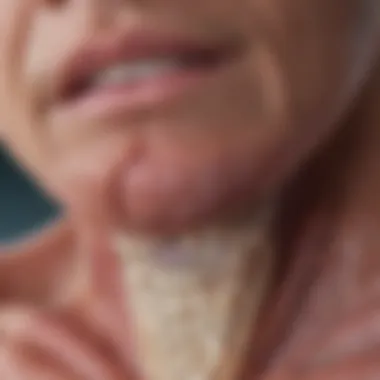Comprehensive Analysis of Mandibular Squamous Cell Carcinoma


Article Overview
Purpose of the Article
The purpose of this article is to provide a thorough examination of squamous cell carcinoma (SCC) that occurs in the mandible. By delving into various factors such as etiology, clinical presentation, and treatment strategies, this piece aims to enhance understanding among healthcare professionals and scholars. The aggressive nature of SCC necessitates a detailed investigation into not just the disease itself but also the best practices in managing it.
Relevance to Multiple Disciplines
SCC of the mandible is relevant across diverse fields, including oncology, dentistry, and oral pathology. Its multifactorial nature warrants a multidisciplinary approach to improve diagnosis and treatment.
The findings discussed in this article will be pertinent not only to medical professionals but also to researchers involved in studying cancer biology. Insights from this work can potentially lead to better patient outcomes and inform future studies in related domains.
Research Background
Historical Context
Understanding the history of SCC is crucial for grasping its current implications. The interest in oral cancers, particularly SCC, dates back several decades. Early studies focused primarily on incidence and demographics, revealing that men are generally at higher risk than women. Research has evolved to investigate genetic and environmental influences, leading to a more nuanced view of the disease.
Key Concepts and Definitions
To lay a proper foundation for this exploration, several key concepts must be defined:
- Squamous Cell Carcinoma (SCC): A malignant tumor arising from squamous epithelial cells, commonly found in various organs, including the skin, lungs, and oral cavity.
- Mandible: The lower jawbone, which plays a crucial role in functions such as chewing and speaking.
- Local Invasion: The tumor's extensiveness within local tissues, which greatly influences prognosis and treatment pathways.
As the complexities of SCC are unravelled, it becomes evident that an interdisciplinary approach is essential for effective management and improved patient care.
"Understanding squamous cell carcinoma in the mandible is vital for developing better treatment modes. The disease's aggressiveness demands immediate and informed actions."
"Understanding squamous cell carcinoma in the mandible is vital for developing better treatment modes. The disease's aggressiveness demands immediate and informed actions."
This article seeks to provide a comprehensive narrative by examining these key aspects in detail, ultimately guiding better practices in the clinical setting.
Prelude to Squamous Cell Carcinoma
Squamous cell carcinoma (SCC) of the mandible is a critical topic in the field of oncology and dentistry. Understanding this malignancy is essential for healthcare professionals, researchers, and students. The mandible's unique anatomical and physiological considerations make SCC a complex entity that demands detailed exploration.
The importance of this section lies in its ability to explain fundamental concepts related to SCC. This knowledge is crucial for identifying patients at risk, diagnosing the disease earlier, and implementing effective treatment plans. Moreover, thorough insight into the definition and epidemiology of this cancer type informs subsequent sections of this article, allowing readers to appreciate the clinical context of SCC.
In discussing SCC of the mandible, various aspects must be highlighted:
- Clinical challenges arising from the aggressive nature of the disease.
- Treatment difficulties due to the mandible's involvement in essential functions such as chewing and speaking.
- The necessity of interdisciplinary collaboration among surgeons, oncologists, and supportive care teams.
By addressing these considerations, this section forms a foundation for deeper discussions related to etiology, risk factors, diagnostics, and treatment options for SCC of the mandible.
Definition and Overview
Squamous cell carcinoma is a malignant neoplasm that arises from squamous epithelial cells. When occurring in the mandible, it typically exhibits aggressive behavior and can lead to significant morbidity. The lesion often begins as a superficial abnormality that can evolve into a deeper invasion of surrounding tissues.
The oral cavity's role as a site for various carcinogenic factors particularly elevates the risk for SCC. These factors include irritation from non-healing ulcers, tobacco use, and exposure to certain viruses, especially human papillomavirus (HPV).
Incidence and Epidemiology
The incidence of squamous cell carcinoma in the mandible is notably significant. While the exact figures can vary based on geographic and demographic factors, this cancer type represents a prominent portion of oral malignancies. It is critical to examine the epidemiological trends associated with SCC to understand its impact better.
Some noteworthy points include:
- Incidence rates are rising in certain populations, especially in young adults who might be affected by HPV.
- Demographic characteristics, such as age and gender, also play roles in susceptibility, with males generally showing higher rates than females.
- Geographic distribution shows variations, often impacted by local habits, prevalence of risk factors, and socioeconomic conditions.
These epidemiological insights guide clinical vigilance and public health interventions aimed at reducing risk and improving early diagnosis.
Anatomy and Pathophysiology of the Mandible
The anatomy and pathophysiology of the mandible are crucial to understanding squamous cell carcinoma (SCC) of this region. The mandible, or lower jaw, plays a vital role in supporting the teeth, facilitating chewing, and enabling speech. In the context of SCC, its anatomical features can influence the behavior of the carcinoma and the effectiveness of treatment modalities. Understanding the structure of the mandible provides insights into how tumors may invade surrounding tissues, thereby affecting prognosis and potential management options.
Anatomical Structure of the Mandible
The mandible is the largest bone of the human face, characterized by a U-shaped outline. It consists of various components that contribute to its function. Key features include:
- Body: The horizontal portion that supports the dentition.
- Rami: The two vertical extensions on each side, which connect the body to the skull.
- Angles: The junction between the body and the rami.
- Condyle: The rounded end of the rami that articulates with the temporal bone, allowing for jaw movement.
- Coronoid Process: A thin, flat projection that serves as an attachment point for the temporalis muscle.
These anatomical details are relevant when assessing SCC’s invasion patterns. The proximity to vital structures such as nerves and blood vessels in this area can complicate surgical interventions. Additionally, the mandible’s rich vascular supply may facilitate metastasis in advanced cases, making it essential to identify tumors at an early stage.
Biological Mechanisms of Carcinogenesis


The biological mechanisms underlying the carcinogenesis of SCC within the mandible are complex. Several factors contribute to the transformation of normal squamous cells into malignant ones. These mechanisms typically involve:
- DNA Damage: External carcinogens can induce mutations, particularly in oncogenes and tumor suppressor genes.
- Chronic Inflammation: Prolonged irritation or inflammation of the oral mucosa can promote abnormal cell proliferation.
- Viral Infections: Human Papillomavirus (HPV) has been implicated in some cases of oral SCC, influencing cell cycle regulation and apoptosis.
Understanding these mechanisms sheds light on potential therapeutic targets. For instance, addressing underlying chronic inflammation could lead to preventative strategies. Moreover, knowledge of genetic mutations can inspire personalized treatment approaches. Research into these areas continues to evolve, aiming to improve outcomes for patients diagnosed with this aggressive form of cancer.
Risk Factors for SCC of the Mandible
Understanding the risk factors for squamous cell carcinoma (SCC) of the mandible is vital for both prevention and early detection of the disease. Identifying these factors enhances the ability of healthcare professionals to develop targeted screening protocols and educates patients on the importance of lifestyle choices. The increasing incidence of SCC in certain populations underscores the necessity for awareness around these risk factors.
Tobacco and Alcohol Use
Tobacco and alcohol consumption are among the most significant risk factors associated with the development of SCC in the mandible. Users of tobacco products experience a heightened risk due to the carcinogenic substances present in these products. Studies have shown that tobacco smoking and chewing not only contribute to the initiation of oral cancers but also adversely affect the healing response following surgical interventions.
Alcohol acts synergistically with tobacco, significantly increasing the risk. Regular heavy drinking can lead to mucosal atrophy, leading to increased vulnerability to carcinogens. Furthermore, when combined with smoking, the risk multiplies.
"The combined effects of tobacco and alcohol use substantially elevate the risk for developing oral squamous cell carcinoma, particularly in the mandible."
"The combined effects of tobacco and alcohol use substantially elevate the risk for developing oral squamous cell carcinoma, particularly in the mandible."
Human Papillomavirus (HPV) Infection
Human Papillomavirus, particularly types 16 and 18, has emerged as a notable risk factor in the development of SCC of the mandible. HPV infection alters the cellular mechanisms of the epithelia, leading to dysregulated growth and increased malignancy potential. Studies show that HPV-positive SCC cases often have better response rates to treatment compared to their HPV-negative counterparts.
Moreover, the prevalence of HPV is rising among younger populations, necessitating further investigation into its role in oral carcinogenesis. Vaccination against HPV is also a proactive measure that could significantly reduce the incidence of these types of cancers.
Chronic Inflammation and Immunosuppression
Chronic inflammatory conditions can create an environment that is conducive to cancer development. For instance, conditions like periodontitis lead to continuous inflammatory stimuli that can promote the malignant transformation of epithelial cells.
Additionally, immunosuppression—whether due to medical conditions, treatments, or chronic infections—dramatically increases the risk of SCC in the mandible. A compromised immune system does not effectively eliminate malignant cells, allowing them to proliferate unchecked. This interaction between inflammation, immunity, and cancer emphasizes the need for vigilant monitoring and risk assessment in at-risk populations.
In summary, the risk factors associated with SCC of the mandible are multifaceted. These include lifestyle choices and biological factors that can significantly influence the onset and progression of the disease. Recognizing and addressing these risks can lead to improved screening, prevention, and ultimately, better patient outcomes.
Clinical Presentation
Understanding the clinical presentation of squamous cell carcinoma (SCC) of the mandible is critical for effective diagnosis and treatment. This section aims to elaborate on the symptoms and signs associated with the disease and the staging process. These elements hold significant implications for prognosis and therapeutic strategies. By recognizing symptoms early, healthcare providers can ensure better patient outcomes as they facilitate prompt diagnosis.
Symptoms and Signs
The symptoms of SCC of the mandible often emerge gradually. Patients may initially experience vague discomfort, which can lead to delays in seeking medical attention. Common signs to note include:
- Persistent pain in the jaw or mouth, which may not improve with over-the-counter pain relievers.
- Swelling or a noticeable lump in the jaw area.
- Change in voice or persistent hoarseness.
- Difficulty swallowing or chewing, suggesting structural involvement of the mandible.
- Ulcerations or lesions that do not heal over time.
These symptoms can be alarming, leading to increased anxiety in patients. Recognizing these signs early is paramount, as they frequently indicate advanced disease. Regular oral examinations and awareness of symptomatology are vital in high-risk populations.
Staging of the Disease
Staging is an essential aspect of managing SCC of the mandible. It assesses the extent of tumor spread and guides treatment decisions. The most common system used is the TNM classification system, which evaluates:
- T (Tumor Size): The size and extent of the primary tumor are crucial in determining severity.
- N (Node involvement): This indicates whether regional lymph nodes are affected. It is significant for predicting prognosis.
- M (Metastasis): This evaluates whether cancer has spread to distant organs.
Understanding the stage of the disease helps in formulating a treatment plan. Early-stage cancers might only require surgical intervention, while advanced stages may necessitate a combination of surgery, radiation, and chemotherapy.
Early intervention significantly increases the likelihood of positive outcomes in SCC cases. Knowledge and awareness of symptoms can save lives.
Early intervention significantly increases the likelihood of positive outcomes in SCC cases. Knowledge and awareness of symptoms can save lives.
Diagnostic Methods for SCC of the Mandible
Diagnostic methods play a critical role in the management of squamous cell carcinoma (SCC) of the mandible. Accurate diagnosis is essential for determining the stage of the disease and planning appropriate treatment strategies. Early detection of SCC can dramatically influence patient outcomes and enable timely interventions that can enhance survival rates. A multifaceted approach involving imaging techniques, histopathological examination, and molecular diagnostics is necessary to achieve a comprehensive assessment of the malignancy. Each method contributes to a clearer understanding of tumor behavior and patient prognosis.
Imaging Techniques
Imaging techniques are the cornerstone of the diagnostic process for SCC of the mandible. They help in visualizing the tumor and assessing its extent. Common methods include:
- Computed Tomography (CT): Provides detailed cross-sectional images of the mandible, helping evaluate bone involvement and regional lymph nodes.
- Magnetic Resonance Imaging (MRI): Useful for soft tissue evaluation and better visualization of the attachment to adjacent structures. MRIs are particularly beneficial in determining the nuances of bone marrow infiltration, which is not as easily seen on CT scans.
- Positron Emission Tomography (PET) Scans: Often used in conjunction with CT or MRI, PET scans help to identify metabolically active disease, allowing for more accurate staging and treatment planning.
These imaging modalities not only help in the initial diagnosis but also play a role in monitoring treatment response and detecting recurrences. However, the choice of imaging technique must be tailored to the individual patient’s needs and the clinical context.
Histopathological Examination
Histopathological examination remains a definitive diagnostic tool in identifying SCC of the mandible. Tissue samples are typically obtained via biopsy, which can be performed through several methods, including:
- Incisional Biopsy: A portion of the tumor is removed to determine histological characteristics.
- Excisional Biopsy: The entire lesion is removed for examination, which may be appropriate for smaller tumors.
- Fine Needle Aspiration (FNA): Used for lymph nodes suspected of metastatic involvement.


Once the sample is acquired, a trained pathologist examines it under a microscope. This examination allows for the identification of atypical squamous cells and assessment of tumor grade. Key factors considered in histopathology include:
- Degree of Differentiation: Helps predict aggressive behavior of the tumor.
- Lymphovascular Invasion: Indicates if the tumor has invaded lymphatic or vascular channels, signifying a higher risk for metastasis.
- Margin Status: Ensures complete removal of the cancerous tissue.
Histopathology remains a gold standard for diagnosis and crucial for establishing a baseline for future comparisons during treatment.
Molecular Diagnostics
Molecular diagnostics is an emerging field that offers additional insights into the biology of SCC. This approach involves analyzing specific biomarkers associated with the disease. In the context of SCC of the mandible, the following aspects are particularly relevant:
- Genetic Testing: Identification of mutations in genes, such as TP53 or PIK3CA, which can inform prognosis and treatment options.
- Biomarker Expression: Evaluating the expression of proteins like p16INK4a, which can suggest HPV-related carcinoma, influencing therapy choices.
- Liquid Biopsy: A less invasive technique involving the analysis of circulating tumor DNA (ctDNA) from blood samples, providing real-time information about tumor dynamics.
Understanding the genetic and molecular profile of the tumor can facilitate personalized treatment approaches, thus optimizing patient care.
Molecular diagnostics have the potential to revolutionize how we understand and treat SCC of the mandible, paving the way for targeted therapies.
Molecular diagnostics have the potential to revolutionize how we understand and treat SCC of the mandible, paving the way for targeted therapies.
Treatment Options
Effective treatment of squamous cell carcinoma (SCC) of the mandible is essential for improving patient outcomes. Understanding treatment options allows healthcare professionals to tailor strategies based on the cancer's specific characteristics and the patient's overall health. The treatment landscape incorporates several modalities, including surgical management, radiation therapy, and chemotherapy. Each method contributes uniquely to controlling the disease and enhancing survival rates.
Surgical Management
Surgical management often serves as the primary modality for treating SCC of the mandible. The objective is to excise the tumor with clear margins, minimizing the risk of recurrence. Several factors influence the surgical approach:
- Extent of the Tumor: Tumors can vary widely in size and invasion depth.
- Location within the Mandible: Specific locations may pose unique challenges.
- Patient's Functional Needs: Consideration of functions such as chewing and speech is vital.
Common procedures include partial or total mandibulectomy, depending on the tumor's extent.
"Surgical intervention remains the cornerstone of treatment for resectable squamous cell carcinoma of the mandible."
"Surgical intervention remains the cornerstone of treatment for resectable squamous cell carcinoma of the mandible."
Reconstructive surgery may follow to restore aesthetics and function. Techniques such as free flap construction may be utilized. This dual approach enhances the quality of life post-surgery while addressing oncological needs.
Radiation Therapy
Radiation therapy acts as a complementary treatment. It can be utilized either as an adjuvant therapy following surgery or as a primary intervention when surgery is not feasible. Key considerations include:
- Tumor Location: Proximity to sensitive tissues can impact delivery methods.
- Dose and Fractionation: The precision of radiation dosing can influence outcomes.
- Potential Side Effects: Side effects, like mucositis and xerostomia, can affect patient quality of life.
Radiation therapy targets residual cancer cells, thereby reducing the likelihood of recurrence. Advanced techniques such as intensity-modulated radiation therapy (IMRT) allow for targeted delivery, minimizing damage to surrounding healthy tissues. This precision enhances therapeutic efficacy while mitigating adverse effects.
Chemotherapy and Targeted Therapy
Chemotherapy may serve a pivotal role, particularly in advanced cases or those exhibiting aggressive pathological features. This treatment can reduce the tumor size, making surgical resection more feasible. In recent years, targeted therapies have gained prominence as they offer a more specific approach:
- Chemotherapy: Typically involves combinations of agents such as cisplatin or carboplatin. This approach aims to eliminate rapidly dividing cells.
- Targeted Therapy: Focuses on specific molecular abnormalities present in cancer cells. Drugs like cetuximab target the epidermal growth factor receptor (EGFR) and can enhance treatment outcomes for specific patient subsets.
Combining chemotherapy with targeted therapies may improve effectiveness and limit toxicities. Patient monitoring during therapy is crucial to manage potential side effects and evaluate treatment response.
Prognosis and Outcomes
Understanding the prognosis and outcomes of squamous cell carcinoma (SCC) of the mandible is crucial for both patients and healthcare professionals. Prognosis refers to the likely course or outcome of the disease, which often directly influences treatment decisions and patient management. Predicting outcomes for SCC of the mandible takes into account several factors, including disease stage at diagnosis, the patient's overall health, and the effectiveness of the chosen treatment strategies. This section will explore these aspects in detail, offering valuable insights about what to expect during the course of the disease.
Survival Rates
Survival rates for patients with SCC of the mandible vary significantly. Factors such as the stage of cancer at diagnosis play a vital role. Generally, the five-year survival rate for localized SCC can range from 60% to 90%. When the cancer has spread regionally, this rate can drop to about 40% to 60%. If distant metastasis occurs, survival rates diminish further, often falling below 20%.
The usage of modern therapies has improved outcomes over the last few decades. Improvements in surgical techniques, radiation therapy, and targeted treatments contribute positively. For instance, patients receiving combined modality treatment commonly show better survival rates compared to those treated with a single approach. Understanding these survival statistics is imperative for patients and families as they navigate the complexities of treatment and make informed decisions about their care plan.
Factors Influencing Prognosis
Several factors can influence the prognosis of SCC of the mandible. Key considerations include:
- Tumor Size and Location: Larger tumors or those located in areas difficult to treat often show a poorer prognosis.
- Lymph Node Involvement: Presence of cancer in nearby lymph nodes is a significant negative prognostic indicator, as it suggests a higher likelihood of systemic spread.
- Histological Grade: The aggressiveness of the tumor, as determined by histological examinations, can indicate how quickly the cancer is likely to grow.
- Patient Factors: Age, comorbidities, and lifestyle choices can affect treatment response and overall survival.
Research Advances and Innovations
Research into squamous cell carcinoma (SCC) of the mandible is imperative for understanding this aggressive malignancy. As the landscape of cancer treatment evolves, these advances can lead to improved patient care and outcomes. The innovations in SCC research are encouraging, aiming to refine existing treatment modalities and introduce novel strategies.
Novel Therapeutic Approaches
Recent studies have focused on discovering novel therapeutic regimens that can enhance existing treatment paradigms. These include targeted therapies that seek to inhibit specific molecular pathways involved in SCC progression. One promising area is the use of histone deacetylase inhibitors, which may potentially reverse aberrant gene expression in cancer cells.


Additionally, researchers are exploring combinations of traditional treatments, such as chemotherapy and radiation, with newer agents. This combination approach may help overcome resistance and improve efficacy. For instance, incorporating antibiotics with chemotherapeutic agents is being investigated for its potential to enhance anti-cancer effects.
Moreover, personalized medicine is becoming a crucial aspect of SCC therapy. Genetic profiling of tumors allows physicians to select therapies tailored to the individual’s unique cancer profile. This customization is critical as it may spare patients from unnecessary side effects associated with less suitable treatments.
Immunotherapy Developments
Immunotherapy is at the forefront of research in cancer treatment, including SCC of the mandible. This approach aims to harness the body's immune system to recognize and fight cancer cells. Recent advancements in immune checkpoint inhibitors, such as pembrolizumab, have shown promise in increasing survival rates for advanced cases of SCC.
Research is also investigating the role of cancer vaccines in preventing relapse. Such vaccines can activate the immune response specifically against tumor antigens, aiming for a more targeted attack on aberrant cells. The challenge remains in identifying the most effective antigens for SCC, but ongoing clinical trials are providing more insights into this potential.
Furthermore, chimeric antigen receptor (CAR) T-cell therapy has garnered attention as a potent immunotherapeutic strategy. This involves genetically modifying a patient’s T cells to enhance their ability to attack malignant cells. Although the efficacy in SCC is still under evaluation, early results are promising and warrant further exploration.
"The future of SCC treatment will rely significantly on innovations that embrace personalized and targeted strategies, promising a shift in patient outcomes."
"The future of SCC treatment will rely significantly on innovations that embrace personalized and targeted strategies, promising a shift in patient outcomes."
In summary, research advances in novel therapeutic approaches and immunotherapy developments are critical to improving treatment for squamous cell carcinoma of the mandible. These innovations not only provide hope for patients but also inspire continued exploration in a field that is ever-evolving.
Patient Care and Support
Patient care and support forms a critical aspect in managing squamous cell carcinoma (SCC) of the mandible. Effective management not only addresses the physical aspects of the disease but also supports patients emotionally and psychologically during treatment. Comprehensive care incorporates various strategies aimed at improving the quality of life of the patient while navigating the complexities of treatment and recovery.
Palliative Care Strategies
Palliative care plays a vital role in the treatment of patients with SCC of the mandible. Its primary objective is to alleviate symptoms and enhance quality of life rather than to cure the illness. This approach assists patients in managing pain, discomfort, and emotional distress associated with their condition. Several palliative strategies can be implemented:
- Pain Management: Effective analgesics, including opioids, can significantly improve patient comfort. Understanding dosages and side effects is essential for optimal use.
- Nutritional Support: Many patients experience difficulty in eating and swallowing due to the disease. Consulting a nutritionist to develop a suitable diet can help prevent malnutrition and maintain energy levels.
- Psychosocial Support: Mental health professionals should be part of the care team. They provide counseling to help patients cope with the psychological impact of their diagnosis and treatment.
Palliative care should be initiated early in the treatment process, often alongside curative measures. It encourages open communication between patients, caregivers, and healthcare providers to ensure that the patient’s preferences and values guide all decision-making processes.
Support Resources for Patients and Families
Support resources are essential for patients and their families facing SCC of the mandible. These resources provide vital assistance, information, and community engagement crucial during the treatment journey. Various options are available:
- Support Groups: Connecting with others who share similar experiences can provide emotional relief and valuable insights. Organizations often exist locally and online.
- Financial Assistance Programs: Costs associated with treatment can be overwhelming. Several non-profit organizations offer resources and financial aid for medical expenses.
- Educational Resources: Websites such as Wikipedia and Britannica offer comprehensive information about SCC. Educating oneself about the illness can empower both patients and their families.
- Helplines and Hotlines: Many organizations provide hotlines for immediate support and guidance regarding emotional and logistical concerns.
"Patient-centered care must take a holistic view, addressing not just the physical aspects of illness, but the emotional and social dimensions as well."
"Patient-centered care must take a holistic view, addressing not just the physical aspects of illness, but the emotional and social dimensions as well."
Engaging families and support networks is essential as they contribute significantly to the healing process. Adequate support improves the overall experience for patients, guiding them through one of the most challenging times in their lives.
Future Directions in Research
Research into squamous cell carcinoma (SCC) of the mandible is crucial, as it holds the potential to address significant gaps in understanding and treatment of this malignancy. By focusing on future directions, we can identify evolving strategies that may enhance patient care and outcomes. Increased investment in this area could yield benefits for both clinical practices and the educational landscape surrounding this disease.
Emerging Trends in Research
Emerging trends in research indicate a shift toward more personalized treatment methods. This movement is rooted in advancements in genomic studies and a greater understanding of the tumor microenvironment. The identification of specific biomarkers has potential to tailor therapies to individual patient profiles, enhancing efficacy while minimizing adverse effects. Topics under investigation include the role of circulating tumor DNA and targeted therapies designed to disrupt particular pathways implicated in the progression of SCC.
Furthermore, there is rising interest in integrating artificial intelligence and machine learning into diagnostic processes. These technologies can assist in interpreting images more accurately and quickly, potentially improving detection rates of mandible SCC at earlier stages.
Collaborative Research Initiatives
Collaborative research initiatives play a vital role in advancing the understanding of SCC of the mandible. Multi-institutional partnerships can lead to larger sample sizes in studies, which is essential for drawing significant conclusions. For instance, initiatives that connect academic institutions, healthcare providers, and industry can accelerate the development of novel treatment modalities. Such collaborations can facilitate the sharing of data, ensuring that findings are validated across different populations and settings.
"The future of SCC research relies heavily on cooperation among various sectors, enabling us to tackle the disease more effectively."
"The future of SCC research relies heavily on cooperation among various sectors, enabling us to tackle the disease more effectively."
The National Institutes of Health (NIH) and organizations like the American Cancer Society have begun promoting collaborative projects that emphasize multidisciplinary approaches to research. This approach might encompass epidemiology, molecular biology, and clinical trials. Such comprehensive initiatives not only enhance the quality of research but also draw attention to the importance of addressing SCC from multiple angles.
In summary, future directions in research for squamous cell carcinoma of the mandible promise to reshape our approach to diagnosis and treatment. With heightened focus on personalized medicine and collaborative efforts, the potential for improved patient outcomes increases significantly.
Epilogue
The conclusion of this article emphasizes the importance of understanding squamous cell carcinoma (SCC) of the mandible, as it consolidates key findings and insights gleaned throughout the analysis. By addressing the intricacies associated with SCC, we underscore the multidisciplinary approach necessary for effective management.
Summary of Key Insights
In examining various aspects, several points stand out:
- Aggressive Nature: SCC in the mandible is notably aggressive, often leading to significant morbidity for patients.
- Diagnostic Challenges: Accurate diagnosis is crucial. Techniques like imaging and histopathology are vital in confirming the presence of malignancy and understanding its extent.
- Treatment Options: A blend of surgical intervention, radiotherapy, and chemotherapy is essential for optimal outcomes. Tailoring strategies to individual patient circumstances improves effectiveness.
- Ongoing Research: Advancements in understanding tumor biology and treatment methods are critical in enhancing patient care.
These insights form a foundational understanding for healthcare professionals and researchers involved in the management of SCC. Staying informed assists clinicians in making informed decisions that can drastically improve patient outcomes.
Encouragement for Ongoing Research
Continuous research is imperative in the field of cancer treatment, particularly for SCC of the mandible. The evolution of therapeutic approaches, including:
- Immunotherapy: Emerging as a promising avenue, this approach modifies the patient's immune response against the tumor.
- Targeted Therapies: New agents that focus on specific molecular pathways are being investigated to reduce side effects and improve efficacy.
In light of these developments, collaboration between researchers, oncologists, and support organizations fosters a conducive environment for innovation. Participation in clinical trials should be encouraged, as they provide significant breakthroughs in treatment strategies and augment knowledge in this complex domain.
As our understanding deepens, the goal remains focused on improved prognosis and quality of life for patients diagnosed with SCC of the mandible. Continuous funding and focus on research initiatives will pave the way for future advancements.



